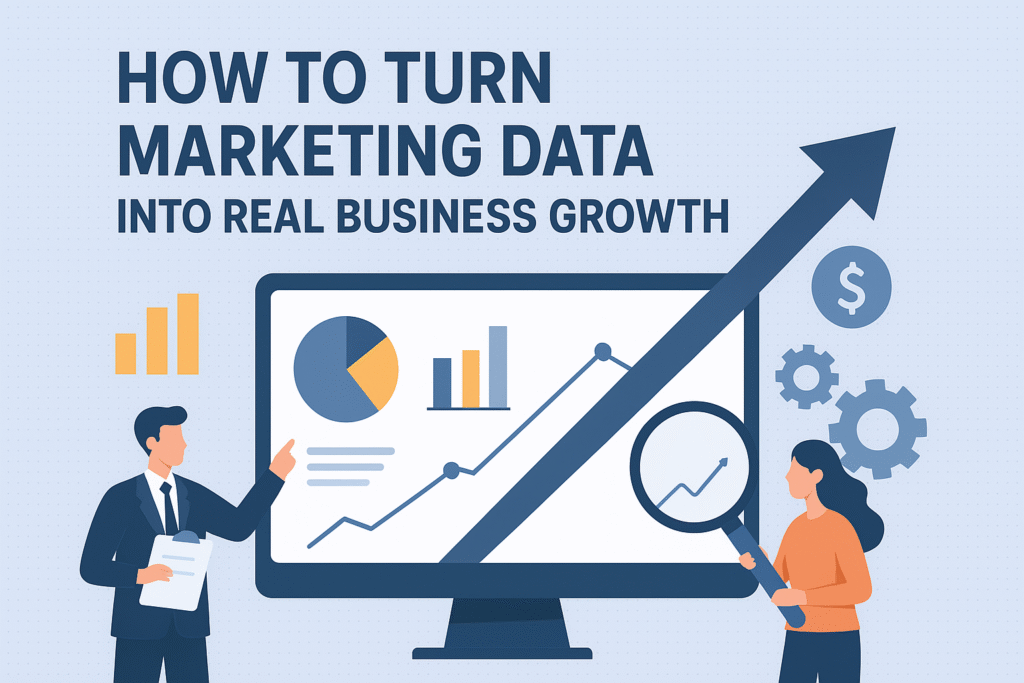
In today’s digital-first world, businesses are sitting on a goldmine of marketing data. From website analytics and social media engagement to email performance and customer feedback, every interaction leaves behind valuable insights. Yet, many organizations struggle to move beyond surface-level reporting and actually use this marketing data for business growth to drive measurable results.
Turning raw marketing data into growth isn’t about collecting more metrics—it’s about knowing what to track, how to interpret it, and how to translate it into action. Below, we’ll break down the steps you can take to transform marketing data into real business outcomes.
Looking to unlock the full potential of your marketing data? Shri Digital
helps businesses turn insights into measurable growth.
1. Start with Clear Business Goals
Too often, companies dive straight into dashboards without asking why the data matters. Metrics in isolation—click-through rates, bounce rates, impressions—don’t mean much if they aren’t tied to bigger business objectives.
Ask yourself:
Are you trying to acquire more customers?
Increase average order value?
Reduce churn?
Grow revenue from existing clients?
When you begin with the business outcome you want, you can select the right marketing metrics to measure progress. For example, if your goal is customer retention, monitoring repeat purchase rates and customer lifetime value will be more important than top-of-funnel impressions.
2. Focus on the Right Metrics, Not Vanity Metrics
It’s easy to get distracted by “vanity metrics” that look impressive but don’t drive revenue—like social media likes or raw website visits. While these numbers can signal brand awareness, they rarely tie directly to growth.
Instead, prioritize actionable metrics such as:
Cost per acquisition (CPA): How much you’re spending to win a customer.
Customer lifetime value (CLV): How much revenue an average customer generates over time.
Conversion rate: How well your campaigns turn visitors into paying customers.
Marketing-attributed revenue: Direct link between campaigns and sales.
By aligning your measurement strategy with these kinds of metrics, you’ll have a clearer view of how marketing contributes to business outcomes.
3. Consolidate Data Across Channels
Modern marketing happens across dozens of touchpoints—social platforms, paid ads, email, search engines, websites, and offline channels. Looking at each source in isolation makes it difficult to see the full customer journey.
Invest in tools that integrate and unify your data, whether through a customer data platform (CDP), CRM integrations, or marketing automation software. By combining datasets, you can trace how someone moves from first engagement (e.g., a social ad) to final purchase (e.g., signing a contract or completing checkout).
A consolidated view reveals bottlenecks and opportunities across the funnel. For instance, you might discover that while Instagram drives the most traffic, LinkedIn generates higher-value leads. That insight helps you allocate resources more effectively.
4. Use Data to Personalize Customer Experiences
Today’s consumers expect relevance. Generic marketing blasts are less effective than tailored experiences that speak directly to customer needs. Data enables this personalization.
Examples include:
Segmenting email lists by past purchase behavior to send targeted product recommendations.
Using website browsing history to deliver dynamic content.
Retargeting ads that align with a customer’s last interaction.
Personalized marketing not only improves customer experience but also increases conversion rates and loyalty—both critical for long-term growth.
5. Identify What’s Working—and What Isn’t
Data is only powerful if you use it to make decisions. This means regularly analyzing campaigns to understand performance.
Ask questions like:
Which channels deliver the highest ROI?
Which campaigns generate the most qualified leads?
Where in the funnel are prospects dropping off?
Sometimes, the results challenge assumptions. You might find that your largest advertising spend is producing the lowest return, while a smaller channel quietly drives conversions. With this knowledge, you can reallocate budgets, double down on high-performing tactics, and cut waste.
6. Embrace Predictive Analytics
Beyond looking backward, advanced analytics allow you to look ahead. Predictive modeling uses historical data to forecast future outcomes, such as which leads are most likely to convert or which customers may churn.
Businesses that embrace predictive analytics gain a competitive edge because they can proactively act on insights rather than react after the fact. For example, identifying at-risk customers early gives you the opportunity to intervene with retention campaigns before you lose them.
7. Make Data Accessible Across Teams
Growth doesn’t happen in silos. Too often, marketing data lives only with the marketing team, disconnected from sales, customer service, and leadership. To maximize impact, data insights should flow freely across the organization.
Sales teams can use marketing insights to tailor conversations with prospects. Product teams can use customer feedback data to prioritize features. Leadership can track how marketing contributes to revenue growth.
Creating a data-driven culture ensures that decisions at every level are aligned and supported by evidence.
8. Turn Insights into Action
The most common mistake businesses make is treating data as the final step instead of the starting point. Dashboards and reports don’t drive growth—action does.
Here’s a simple framework for turning insights into business outcomes:
Identify the trend or anomaly in the data.
Interpret what it means in the context of your business.
Decide what changes to make (e.g., adjust budget, test new creative, shift targeting).
Implement the change.
Measure the results, then repeat.
By creating a continuous loop of data-driven experimentation, businesses can systematically improve marketing effectiveness and growth.
Final Thoughts
Marketing data is one of the most powerful tools available to modern businesses—but only if it’s used strategically. By setting clear goals, focusing on the right metrics, unifying data, personalizing experiences, and creating a culture of action, you can turn raw information into a growth engine.
The companies that thrive in the next decade won’t necessarily be those with the biggest data sets, but those who can translate insights into smarter decisions, better customer experiences, and ultimately, achieve marketing data for business growth.
